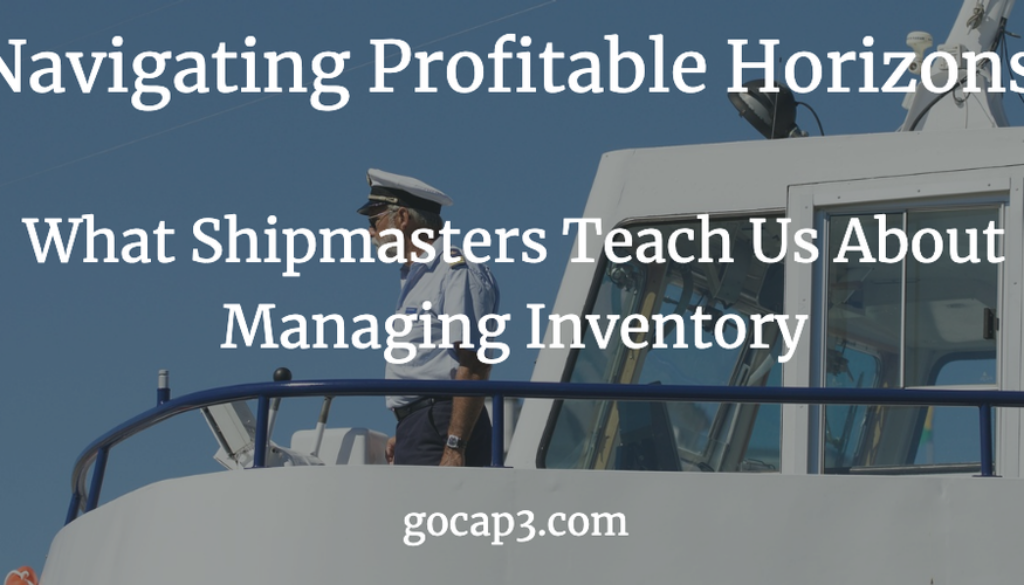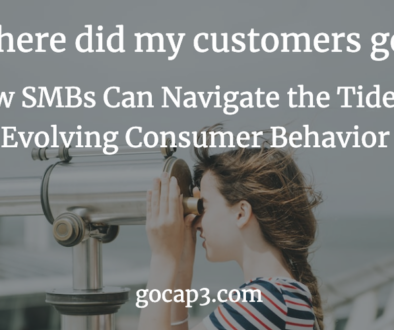Navigating Profitable Horizons: What Shipmasters Teach Us About Managing Inventory
A great business leader is the captain of their ship.
You face the open seas with unwavering resolve. Waves rise and fall, like life’s challenges, testing your mettle.
Amid the vast expanse, you chart a course towards the horizon, guided by stars and experience. Each sunrise paints a new beginning, and in this world of endless possibilities, you embrace the challenge of the unknown, steering towards your destiny.
Waves of Opportunity, the Ebb and Flow of Business
Just like the captain who navigates the open seas with unwavering resolve, the business owner sails through the unpredictable waters of entrepreneurship. Your decisions steer the company’s direction like the captain’s hand on the wheel. Waves of opportunity and adversity rise and fall, mirroring the ebb and flow of business.
Guided by experience, you chart a course through uncharted territories, fueled by ambition and a desire to conquer. In the vast realm of commerce, you embrace uncertainty and shape your own destiny.
Your Inventory is Your Cargo
As you imagine yourself at the helm of this metaphorical ship, know that you are responsible for its cargo – your inventory.
Effective inventory management is like steering a cargo ship through the ever-changing waters of business. Managing inventory is the art of finding equilibrium between surplus and scarcity.
Excessive Inventory
Picture an overloaded vessel struggling through turbulent waves… That’s the consequences of excessive inventory: tied-up finances, restricted workspace, and potential wastage. The ship’s movement is hindered and so is your business’s agility when weighed down by surplus stock.
Insufficient Inventory
On the flip side, imagine a ship barely laden with cargo, entering treacherous waters ill-prepared… That’s the danger of insufficient inventory: stockouts, unmet customer demands, and compromised credibility. The ship’s course is jeopardized and so is your business’s reputation when unable to fulfill orders promptly.
Optimized Inventory
Now envision a ship sailing steadily, cargo efficiently loaded and unloaded at each port… This is the essence of optimized inventory management – maintaining just enough stock to meet demand while avoiding excess. As the ship glides smoothly, maximizing fuel efficiency and maintaining a consistent speed, your business prospers by efficiently utilizing resources and enhancing cash flow.
A Business Leadership Lesson in Inventory Turnover
In this analogy, inventory turnover becomes the compass guiding your ship. It’s the rhythm of goods flowing in and out, balancing supply and demand.
Managing inventory ensures products are readily available when customers need them. Skillful inventory management empowers you to adapt to market changes, seize opportunities, and navigate towards the shores of business success.
Why Inventory Turnover for Businesses is Important
Inventory turnover is a critical metric for businesses that sell products or services. It measures how quickly a business sells and replaces its inventory.
A high inventory turnover rate is typically desirable, as it indicates that a business is selling its products quickly and efficiently. This can lead to increased profits and cash flow.
Benefits to Having a High Inventory Turnover Rate
Reduce Costs
First, it can help businesses to reduce their costs. When inventory turns over quickly, businesses don’t have to spend as much money on storage and handling costs. They also don’t have to worry about their inventory becoming obsolete or damaged.
Improve Cash Flow
Second, a high inventory turnover rate can help businesses to improve their cash flow. When inventory turns over quickly, businesses receive cash from sales more quickly. This can help them to meet their financial obligations and invest in growth opportunities.
Improve Customer Service
Third, a high inventory turnover rate can help businesses to improve their customer service. When businesses have the right amount of inventory on hand, they can fulfill customer orders more quickly and easily. This can lead to increased customer satisfaction and loyalty.
Some Things to Consider
Of course, there are also some challenges associated with having a high inventory turnover rate. For example, businesses may need to invest in more sophisticated inventory management systems to track their inventory levels and ensure that they have the right amount of stock on hand. They may also need to increase their marketing and sales efforts to keep up with demand.
Overall, the benefits of having a high inventory turnover rate far outweigh the challenges. Businesses that can achieve a high inventory turnover rate can expect to see improved profits, cash flow, and customer service.
How to Calculate Inventory Turnover
Inventory turnover is calculated by dividing the cost of goods sold (COGS) by the average inventory value. The formula is as follows:
Inventory turnover = COGS / average inventory value
COGS is the total cost of the products that a business sold during a period of time.
Average inventory value is the average value of the inventory that a business held during a period of time.
To calculate average inventory value, you can use the following formula:
Average inventory value = (beginning inventory + ending inventory) / 2
Beginning inventory is the value of the inventory that a business held at the beginning of a period of time.
Ending inventory is the value of the inventory that a business held at the end of a period of time.
What is a Good Inventory Turnover Rate?
The ideal inventory turnover rate will vary depending on the industry and the specific business. However, in general, a high inventory turnover rate is 12 or more times per year. A low inventory turnover rate is 6 times per year or less.
Businesses can use their industry’s average inventory turnover rate as a benchmark to compare their own performance. They can also use their own historical inventory turnover rates to track their progress over time.
Improving Inventory Turnover
There are several things that businesses can do to improve their inventory turnover rate. These include:
Managing inventory levels carefully: Businesses should make sure that they have the right amount of inventory on hand to meet customer demand. Too much inventory can lead to increased costs and obsolescence, while too little inventory can lead to lost sales.
Using effective inventory management systems: Inventory management systems can help businesses to track their inventory levels, forecast demand, and place orders more effectively.
Optimizing pricing: Businesses should set prices that are competitive and that will encourage customers to buy more products.
Promoting products effectively: Businesses should promote their products through advertising, marketing, and public relations. This can help to increase demand and improve inventory turnover.
By taking these steps, businesses can improve their inventory turnover rate and boost their bottom line.
Let’s See it in Action
Case Study:
“TechGear Solutions” – Mastering Inventory Turn for SMB Success
Introduction:
TechGear Solutions is a small to medium-sized business (SMB) that specializes in providing IT solutions and hardware to businesses in various industries. With a strong commitment to efficient inventory management, TechGear Solutions has not only optimized its cash flow but has also positioned itself as a leading player in the competitive technology market.
Background:
TechGear Solutions was founded a decade ago by a group of IT professionals who recognized the need for reliable, high-quality IT hardware and solutions tailored to the needs of SMBs. From the outset, the company’s leadership recognized the importance of managing their inventory effectively to achieve sustainable growth.
Inventory Turn Strategy:
TechGear Solutions adopted a multi-faceted approach to inventory management that helped them achieve remarkable inventory turnover rates:
Demand Forecasting: The company invested in sophisticated demand forecasting tools that allowed them to predict customer demand accurately. This enabled them to maintain optimal inventory levels and avoid both stockouts and overstocking.
Lean Inventory Practices: Embracing lean inventory principles, TechGear Solutions minimized excess stock by only procuring products that were in high demand or had a strong sales history. This approach ensured that their inventory was in constant motion, contributing to higher inventory turn rates.
Just-in-Time Procurement: TechGear Solutions established partnerships with suppliers that offered quick delivery times. This allowed them to adopt a just-in-time inventory procurement strategy, reducing the need to hold large quantities of stock.
Efficient Supply Chain Management: The company maintained close relationships with suppliers and worked collaboratively to optimize the supply chain. This partnership-based approach helped in streamlining the procurement process and minimizing lead times.
Results:
Through their focused inventory management efforts, TechGear Solutions achieved remarkable results:
High Inventory Turnover: TechGear Solutions consistently maintained an inventory turnover rate significantly higher than industry averages. This allowed them to convert their inventory into cash quickly, supporting their ongoing operations and growth initiatives.
Enhanced Cash Flow: The efficient inventory turnover directly translated into improved cash flow. The company had more capital readily available for business expansion, marketing efforts, and investing in new product offerings.
Customer Satisfaction: By ensuring that the right products were available when customers needed them, TechGear Solutions garnered a reputation for reliability and customer satisfaction. This positive reputation further fueled their growth.
Reduced Holding Costs: Minimized storage costs and reduced obsolescence risks were additional benefits of their optimized inventory practices. The company could allocate resources towards more strategic business activities.
Conclusion:
TechGear Solutions serves as a shining example of an SMB that has mastered the art of inventory turnover. By implementing demand forecasting, lean inventory practices, just-in-time procurement, and efficient supply chain management, they not only optimized cash flow but also established themselves as a thriving player in the competitive technology market.
This case study underscores the potential for SMBs to achieve significant success by prioritizing efficient inventory management as a core business strategy.
Bringing it all together
In the end, whether at sea or in the realm of business, the parallels are undeniable. The journey of a sea captain and that of a business owner share common threads of determination, adaptability, and the pursuit of a defined destination. Both navigate uncharted waters, braving challenges, and seizing opportunities with unwavering resolve.
While the vastness of the open sea and the complexities of the market may differ, the essence of leadership, decision-making, and charting a course towards success remain constant. Just as the sea captain’s tale inspires, so does the journey of the business owner, forging ahead with the helm of ambition and the compass of vision.
Inventory turnover is a critical metric for businesses that sell products or services. A high inventory turnover rate can lead to increased profits, cash flow, and customer service. Businesses can improve their inventory turnover rate by carefully managing inventory levels, using effective inventory management systems, optimizing pricing, and promoting products effectively.
We Can Help
Are you struggling to strike the right balance with your inventory turnover? Contact CAP3 for expert guidance on efficient inventory management and optimizing cash flow. Our solutions offer a range of benefits, including increased profitability through finely tuned inventory levels, reduced storage costs by minimizing excess stock, and data-driven insights for informed decision-making.
Ready to revolutionize your inventory turnover strategies? Connect with us today to explore tailored solutions designed to meet the unique needs of your business. Don’t let inventory challenges hold you back – empower your business with CAP3’s proven expertise and support.




